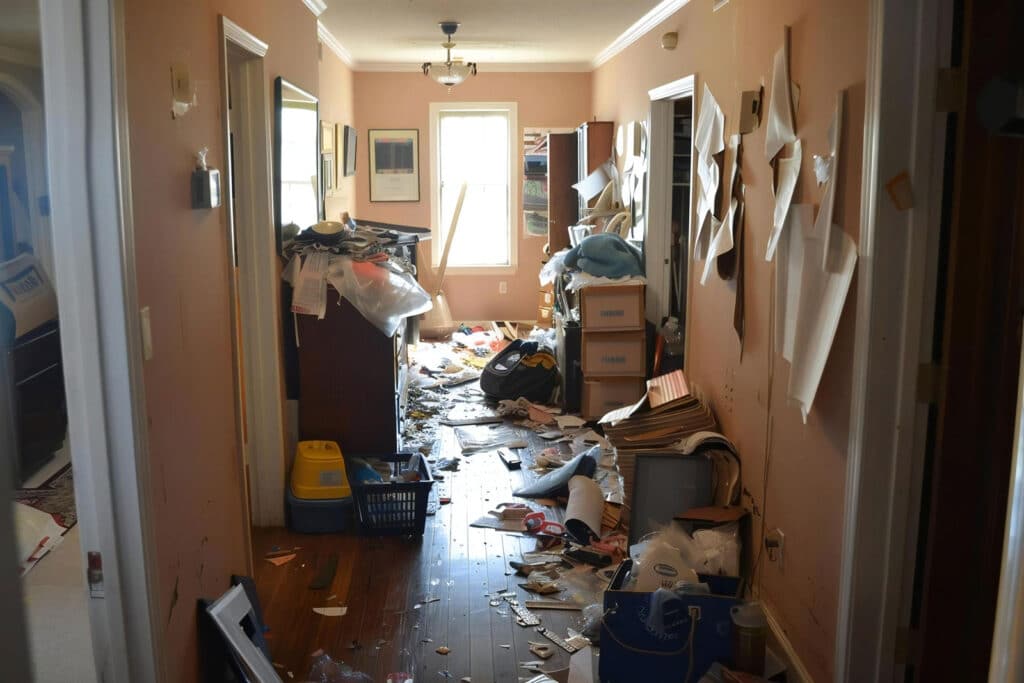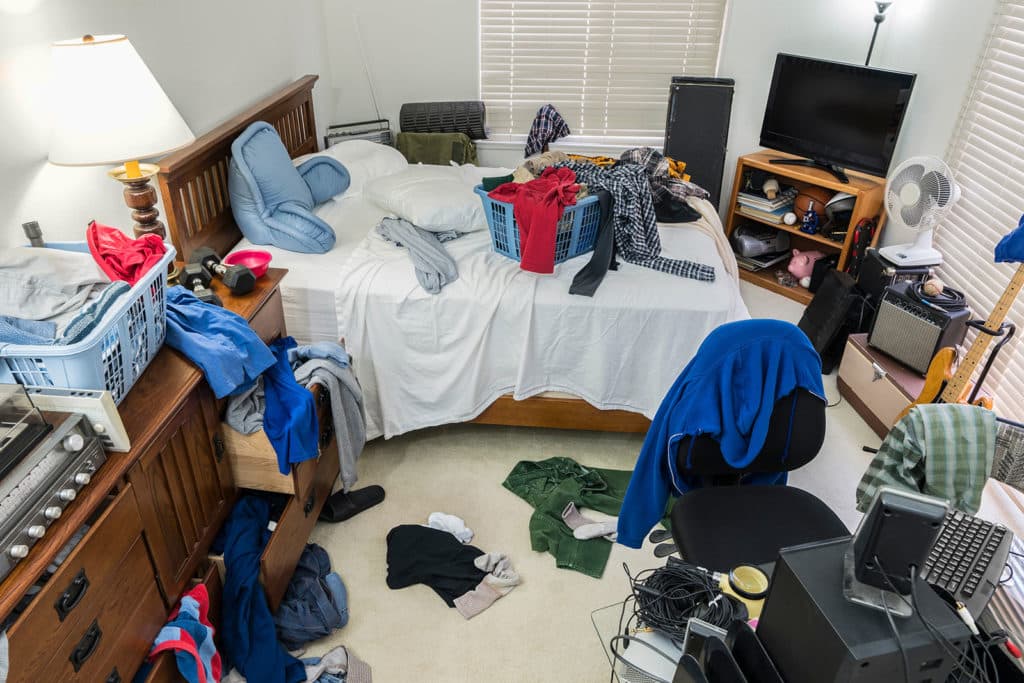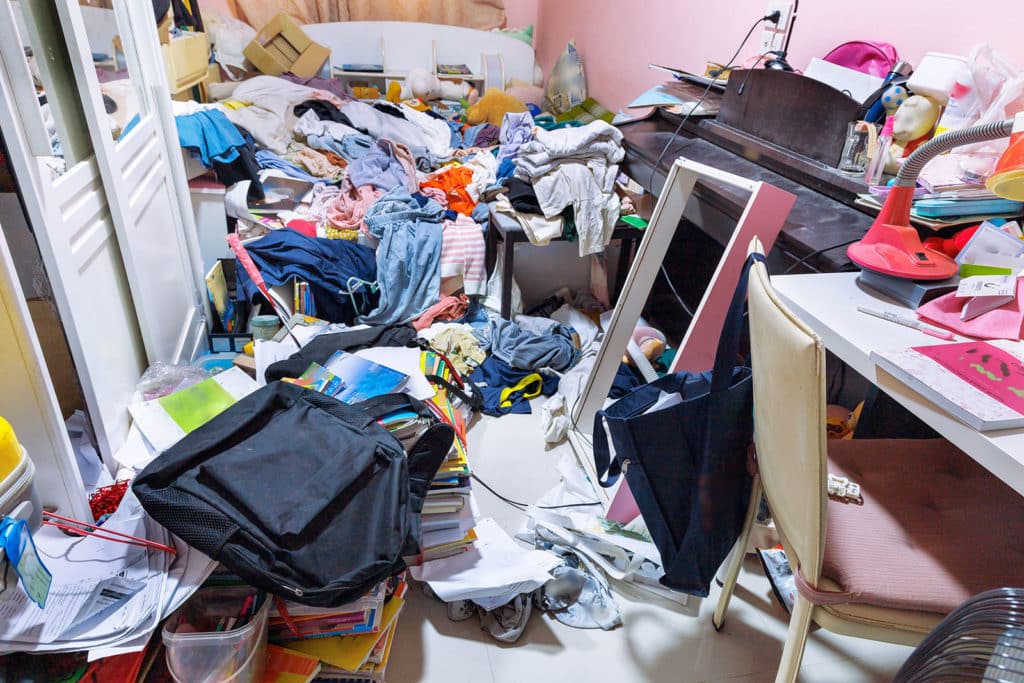Before we dive in too deep, we need to make it clear hoarding isn’t the cute and odd problem some Hollywood movies make it out to be.
It’s not about having a secret cluttered closet you’re embarrassed about or owning more than one version of your favorite book—on that front, you’re quite normal.
A hoarding disorder is a serious mental health condition where individuals find it challenging to discard items, regardless of their value. This behavior can lead to excessive clutter, significantly disrupting living spaces.
According to the International OCD Foundation, almost 2%–6% of the population suffers from this.
Yet, spotting the symptoms can be difficult, especially when so many of us are attached to items because of sentimentality.

That’s why we’re here to help you understand the different stages of hoarding and how it can affect not only the individual suffering but also his loved ones.
Table of Contents
Understanding Hoarding
Hoarding disorder is more than just collecting items or having a messy home; it’s a complex mental health disorder that affects both men and women at the same rate.
In general, this condition is characterized by persistent difficulty in parting with possessions, leading to overwhelming clutter, damaged living spaces, and harmed physical health.
Moreover, hoarding was officially recognized as a distinct disorder and included in the Diagnostic and Statistical Manual of Mental Disorders (DSM-5) for the first time in 2012.
According to their estimates, hoarding affects approximately 2.6% of Americans. This acknowledgment by the American Psychiatric Association marked a significant step in understanding and handling the issue.
The Stages of Hoarding
There are five stages of hoarding and these include the following:
Stage One: Minimal Clutter, Minimal Impact
In the early levels of hoarding, you might notice absolutely nothing. Whatever clutter exists now, doesn’t interfere yet with daily living, making it appear normal.
It could be a remote out of place or extra items kept here or there, but nothing out of the ordinary. To illustrate further, look at the different areas of the home on the Clutter Image Rating first images.
The kitchen, bedroom, and living room are all very tidy with all windows, stairs, and doors accessible. There aren’t any visible signs of mold or infestations and every room seems well-ventilated.
At this hoarding level, it’s a fact that the clutter looks manageable, and the home can still serve its intended purpose by being a haven.
You might see stacks of newspapers, magazines, or mail that seem harmless, but a hint at a deeper reluctance to discard items. Such simple disorganization and the growing collection of seemingly unnecessary things can be easily overlooked.
Sadly, without a professional’s opinion, you can do little at this stage. It can be just that you or your loved one had a long, tiring week, leading to disorganization or general laziness, nothing serious.
However, when it slowly progresses, leading to clutter that may start to encroach on stairways, floors, and tables, the risks get higher.

Stage Two: Noticeable but Mild Clutter
As the hoarding behavior advances to the next stage, the clutter starts to impact daily life more noticeably.
For instance, what do you notice when looking at pictures two and three on the CIR?
The living area began to lose its intended purpose, making it difficult to move around freely and use the space as desired.
The same thing happens to the kitchen and bedroom. What was once a manageable mess, now becomes an obstacle to a comfortable home, leaving the owner embarrassed of visitors.
There are now piles of items, such as newspapers, clothes, and household goods, growing larger and more intrusive.
There’s also a possibility that you can find pet feces or hair, at least one problem with home appliances or electricity, and a blocked exit.
This hoarding situation may lead to insufficient ventilation, causing odors to permeate the house as well as mild mold or mildew.
As a result, one of the key signs of stage two hoarding is the appearance of minor infestations. You might notice an increase in insects like rodents, cockroaches, or ants, drawn by the clutter and possible food remnants.
If you notice these changes, it’s time to encourage small steps to address the clutter and seek professional help if needed.
The earlier the intervention, the better the chance of preventing further escalation and improving the overall well-being of the afflicted individual.
Stage Three: Moderate Hoarding
The closest depictions of this stage are pictures four and five on the CIR. At this point, the clutter has grown to such an extent that accessing stairways and certain rooms becomes a challenge.
The home starts to lose functionality, and the living conditions deteriorate noticeably.
All the possible changes mentioned in stage two become a reality in stage three without intervention.
Please note this stage and beyond truly require professional help.
The sheer volume of possessions piled up in this stage naturally grows out of the control of the individual suffering from this disorder.
You might find the garbage overflowing and multiple surfaces unclean. If they live in a home with a porch, garage, or backyard, you’ll see items spilled from the inside out.
As for the conditions inside, it’s best described as unsanitary and unsafe. With the clutter building up, so do the health risks.
Mildew can develop in damp cluttered spaces and insect infestations become more common as pests find ample hiding spots and food sources.
Other signs of stage three include blocked exits, unclean pets and animal waste, poor ventilation, and electrical or plumbing issues.
If you or a loved one reaches this stage, it’s essential to talk to someone who will understand and not judge.
Mental health professionals can provide the necessary support and strategies to manage the situation.

Stage Four: Severe Hoarding and Structural Damage
When hoarding reaches stage four, the situation becomes dire, with extreme clutter severely impacting personal hygiene and overall living conditions.
Yet, the main issue at this stage is that the individual suffering from the disorder often fails to recognize the severity of the problem.
What you see in pictures six and seven on CIR isn’t as significant to the person affected. That’s to say, their perception is clouded, preventing them from understanding the critical nature of their situation.
Instead, they’re often in an odd headspace with emotions as overflowing as the clutter. They’re also frequently nostalgic, walking down memory lane and making grandiose plans with every corner they take.
However, at this level, the presence of biohazard materials such as human feces and animal waste becomes a grim reality.
These unsanitary conditions pose serious health risks, as bacteria and disease can spread rapidly in such an environment.
The air also becomes thich with noticeable odors, making the home an uncomfortable and unsafe place. Of course, fire hazards increase dramatically due to the excessive accumulation of items.
Flammable materials are often piled high, blocking exits and making it difficult for emergency services to navigate the home in case of a fire. It also makes it hard for the individual to escape and save their life.
Additionally, structural damage becomes a real concern, as mildew and mold eat away at the building.
Stage Five: Extreme Cluttering
When looking at pictures eight and nine on CIR, it’s clear that the space is unlivable and unsanitary. The living conditions at stage five have deteriorated to the point that basic utilities like electricity and running water are often unavailable.
Severe infestations of insects like bed bugs or rodents are common, adding to the already hazardous environment. The clutter at this stage becomes enough that it’s almost impossible to navigate the home.
There are no clear floors or hallways to go through as it’s all cluttered and there’s no electricity to see. Within this level of hoarding, the afflicted person often resorts to making his way through this personal maze by climbing and crawling to move from one spot to the other.
Moreover, because most exits, if not all of them, are blocked at this level, the individual shuddering often stays in one spot, using bottles and containers to get rid of personal waste.
Social isolation also becomes profound at this stage. The embarrassment or shame associated with the state of the home can lead to significant mental illnesses and issues, including depression and anxiety.
The hoarder may withdraw from family members and loved ones, further exacerbating feelings of loneliness and helplessness.

Final Words
We completely understand if you’re frightened after reading about the stages of hoarding. Be it for you or your loved ones, the realization that a hoarding disorder is present can be overwhelming.
Still, you must remember that there is hope. Moreover, with the right support, it’s possible to reclaim a safe and healthy living environment from the jaws of mental illness.
At Illinois Recovery Center, we specialize in compassionate, effective treatment for hoarding disorders.
Whether you or your loved ones need immediate attention or ongoing support, we’re here to help. Reach out to us today, and take the first step towards a clutter-free, safer, and healthier future.



